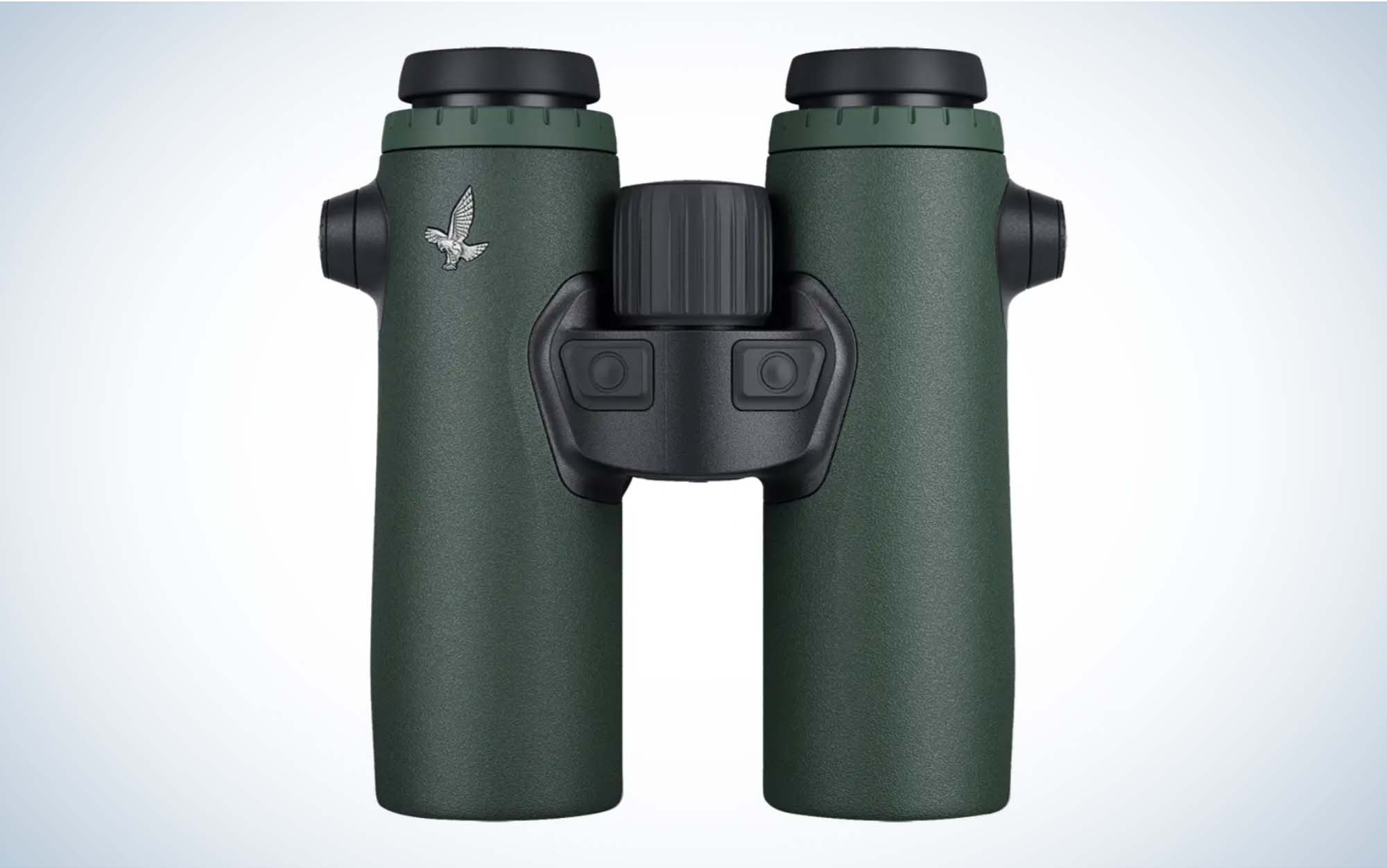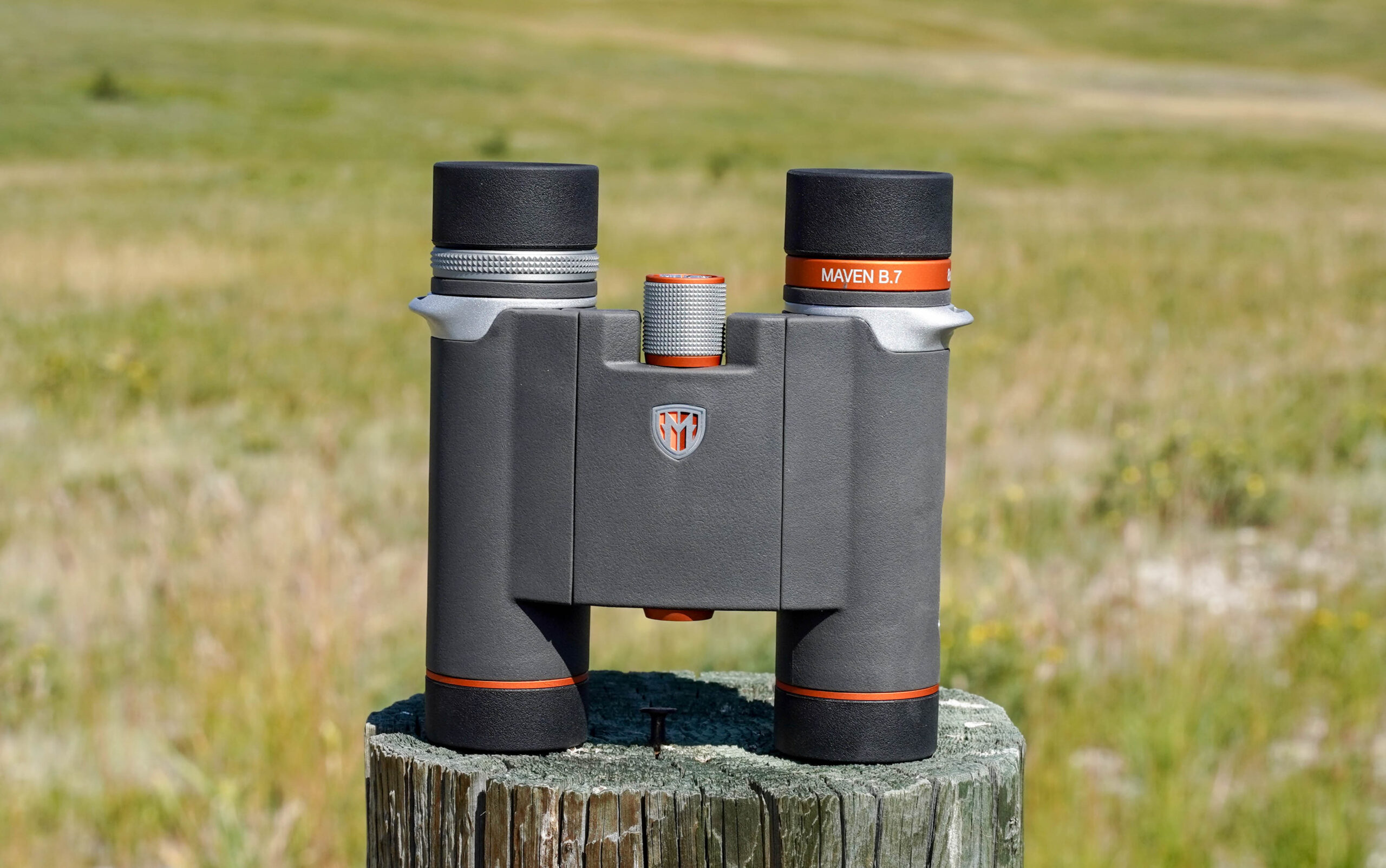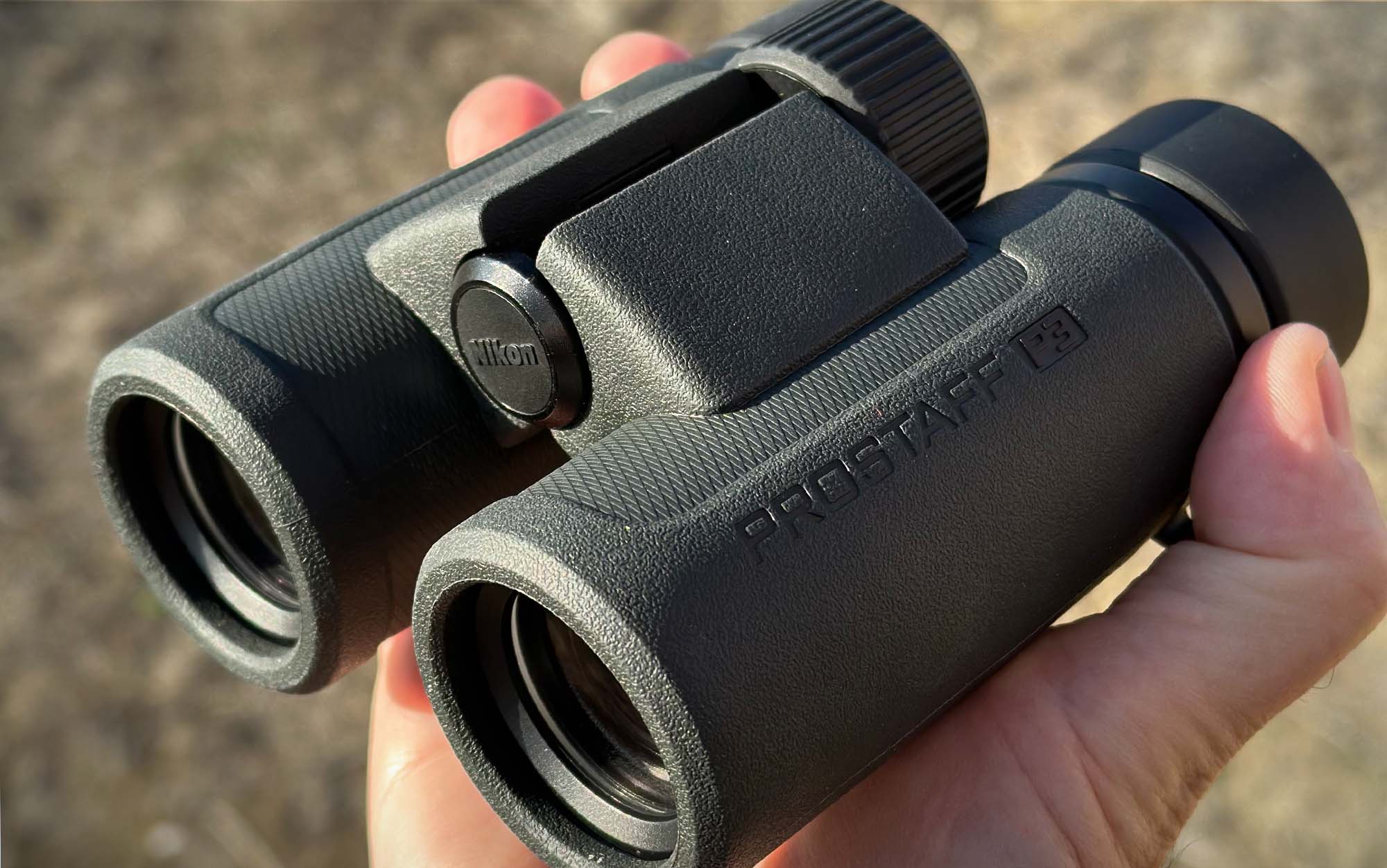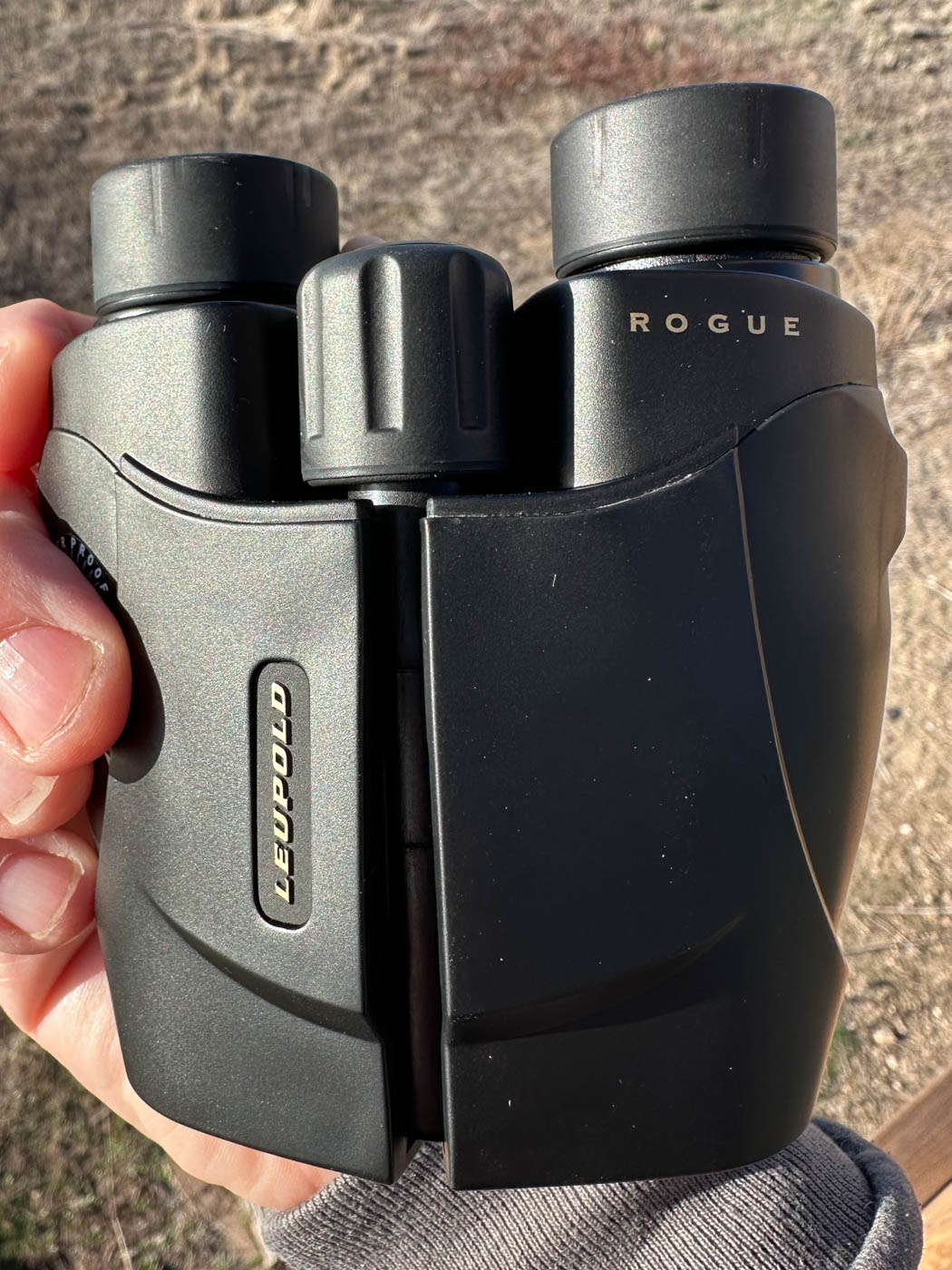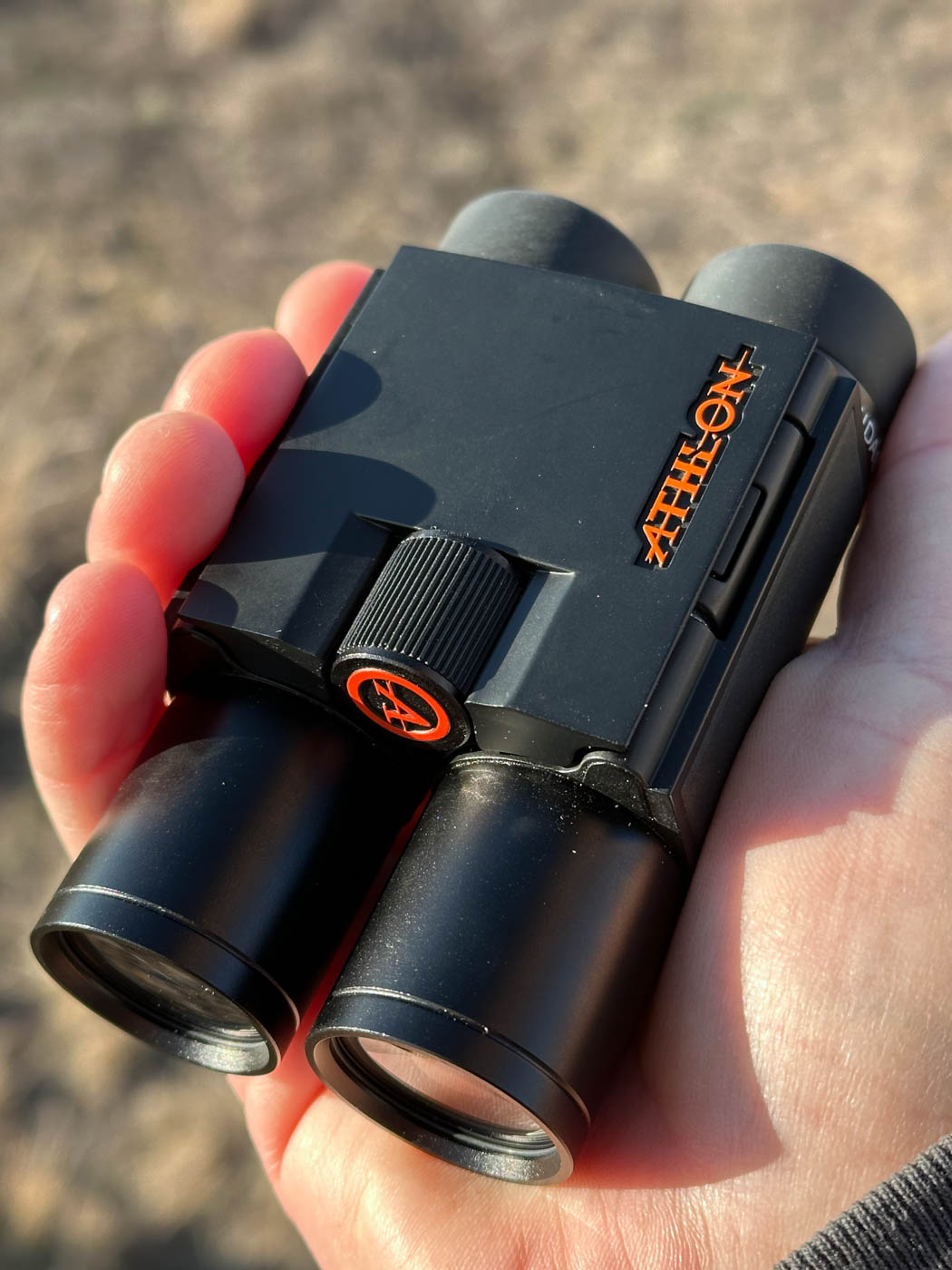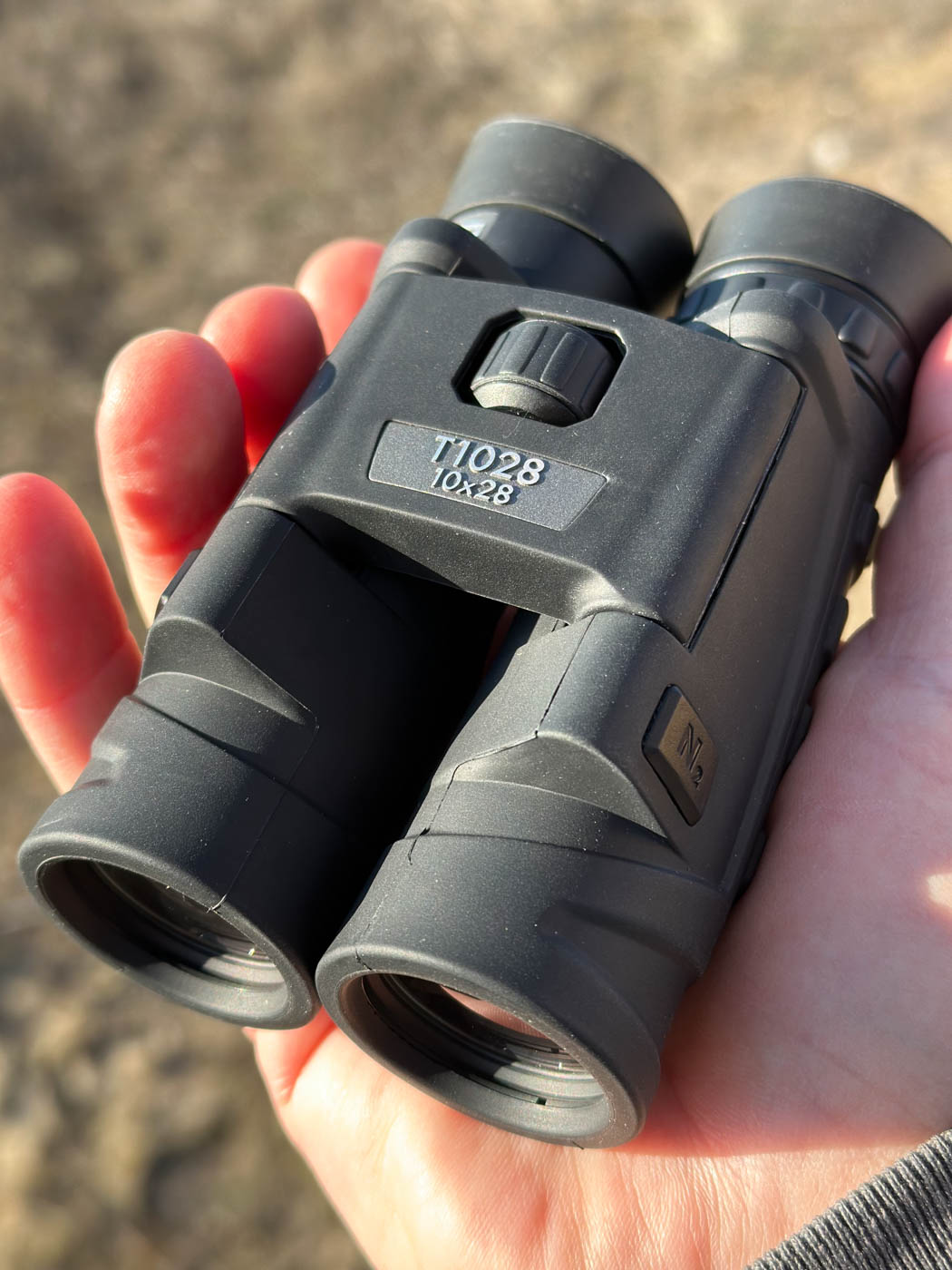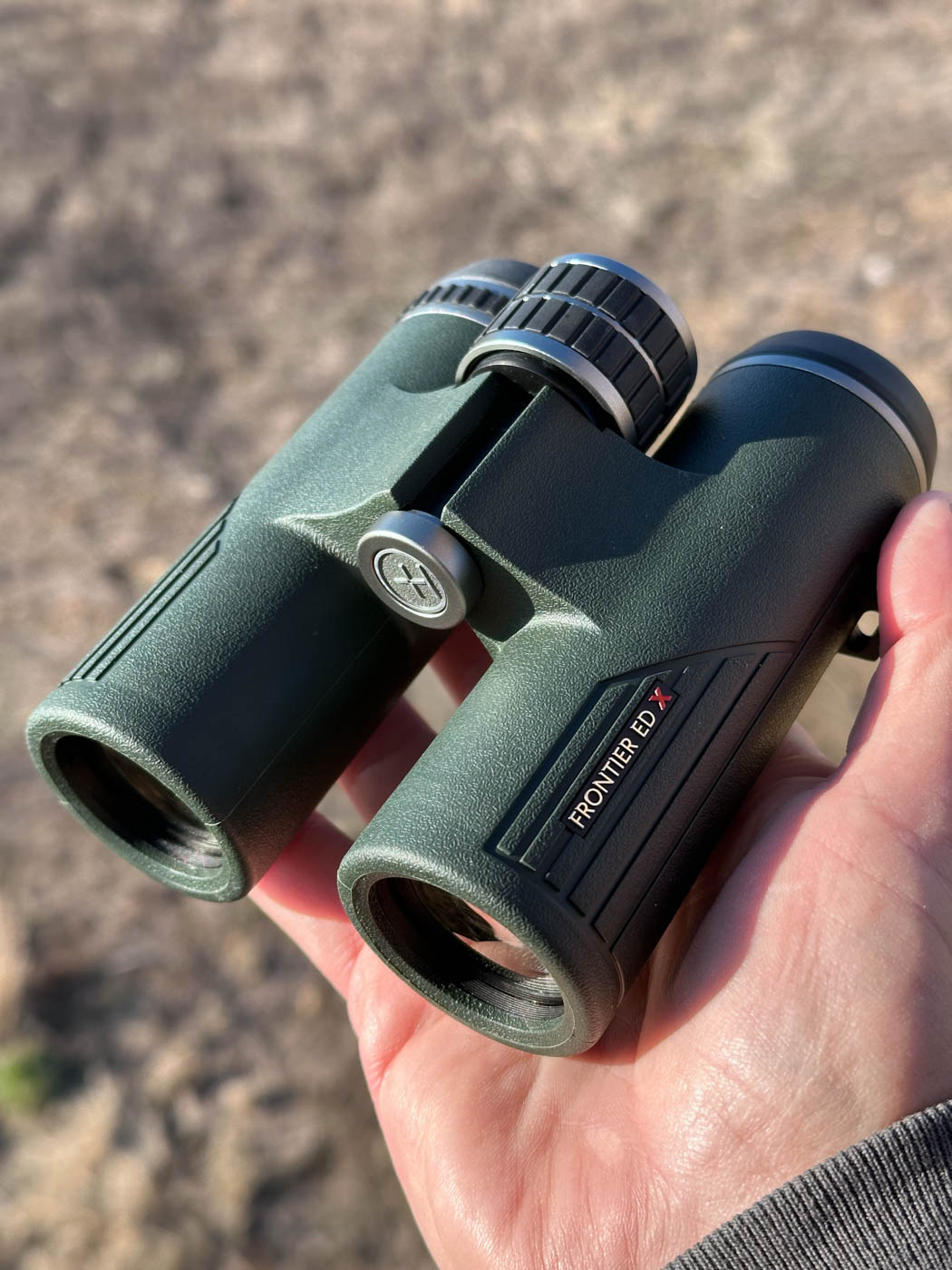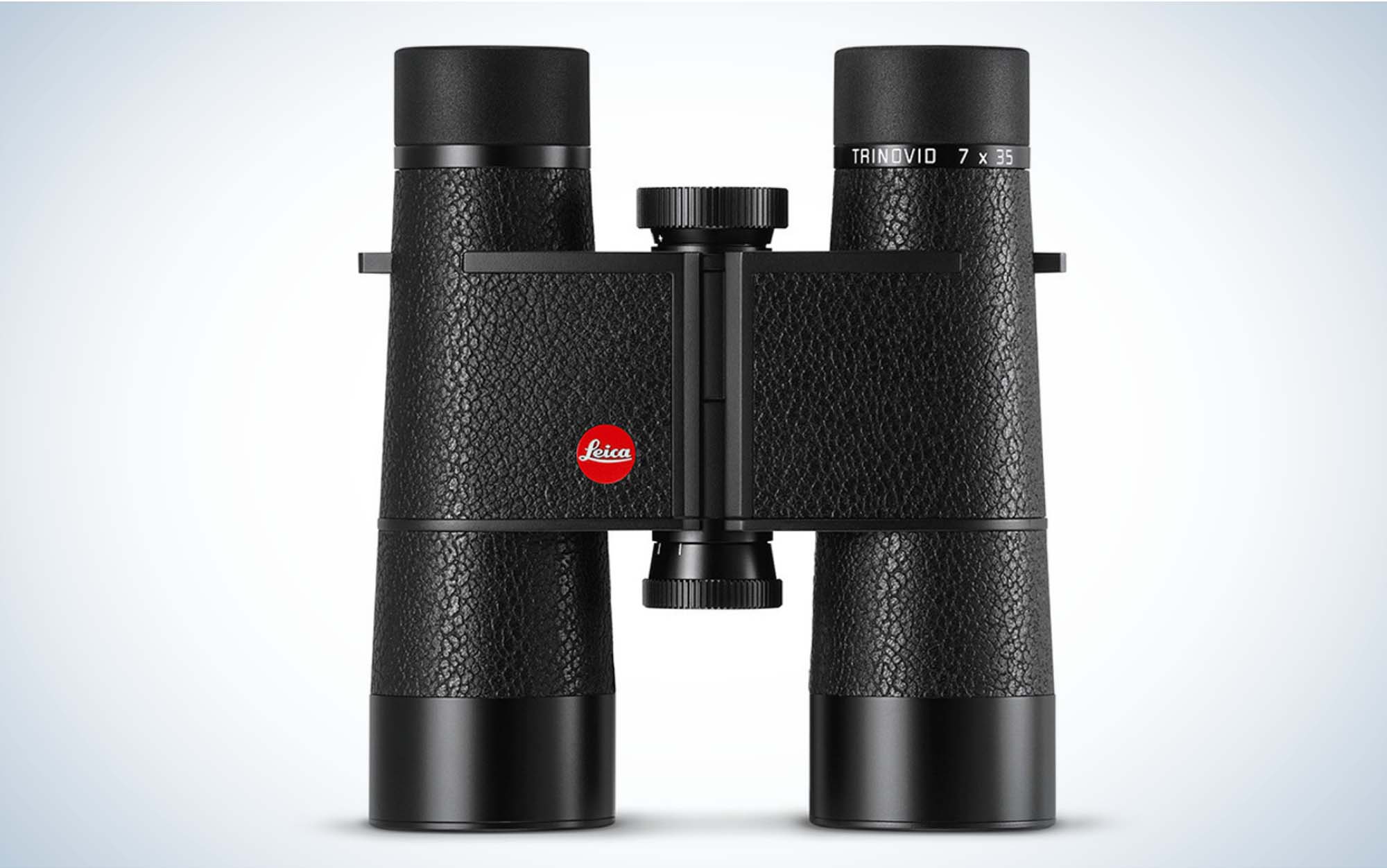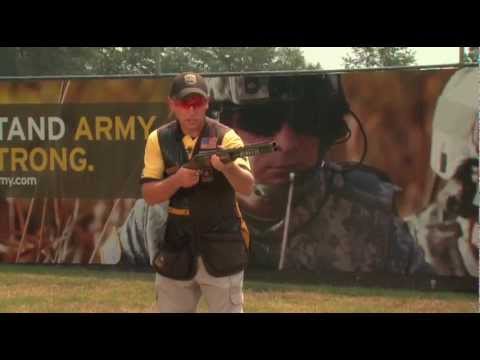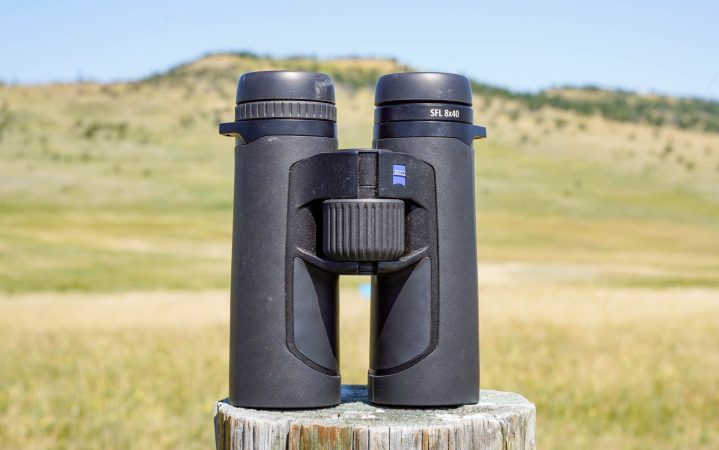The Best Compact Binoculars of 2024, Tested and Reviewed
We may earn revenue from the products available on this page and participate in affiliate programs. Learn More ›
While Western hunters will insist they need a hand-filling 10×42 binocular or even tripod-mounted 15×56 models for most of their hunting and glassing requirements, they’re wrong. A compact 8×32 binocular, with good glass and glare-cutting coatings, has nearly the same optical horsepower of older 10x42s. Also, their smaller frame weighs less, boasts a wider field of view, tucks into standard-size binocular pouches, and is easier to hold steady in high winds or when deployed with a single hand.
The optics industry is recognizing the relatively underserved market for mid-size and compact binoculars, and this year at least a half-dozen models are coming to market, some featuring built-in rangefinders, others optimized for mid-range glassing, and others so small that they’ll tuck into a shirt pocket. Some are configured for treestands and turkey hunting. Still others are great picks for a travel binocular.
Here are eight models, most of them new for this year, but a couple are classics, which I field tested over several weeks this winter and early spring in an effort to introduce you to the best compact binoculars available.
- Best Overall: Swarovski EL Range 10×32
- Best Ultra Compact: Maven B.7 8×25
- Best Budget: Nikon PROSTAFF P3 10×30
- Best Turkey-Vest Binocular: Leupold BX-1 Rogue 8×25
- Best Pocket Binocular: Athlon Midas UHD 10×25
- Best Travel Binocular: Steiner T1028 10×28
- Best All-Around: Hawke Frontier ED X 8×32
- Best Classic: Leica Trinovid 7×35
How I Tested the Best Compact Binoculars
We put all submissions through the same criteria. First, we measure optical resolution, using the diminishing black-and-white lines of a 1951 Air Force Resolution Target to score the optical performance of each submission. We also measure the low-light performance of each binocular by mounting them to tripods and focusing them as a group at 200 yards at a black-and-white resolution target at twilight, all in order to measure the brightness of the glass. This is an important consideration for hunters, since game animals move more in the early morning and late evening than at any other time.
The binocular that can “see” the longest into the gathering darkness gets top marks. The model that loses its night-vision earliest gets the lowest score. Binoculars in the middle receive weighted scores somewhere between those two poles. We average the results over three nights to arrive at our adjusted score.
We break our 10-point scoring into four general categories: optical performance, mechanical performance, design, and value. The average of these categories is the basis of our grades, detailed below.
Optical performance includes the resolution and low-light tests plus the more subjective assessments of image quality and brightness. Mechanical performance assesses the durability of the submission along with its controls: focus and diopter controls, eyecup extension and comfort. In the case of rangefinding binoculars, it also factors the electronic interface and performance. Design considers the exterior finish, interior blacking, tripod mount, and its innovation and versatility along with its comfort. We ask testers to evaluate this critical question: how long could you glass with this binocular?
And then our price/value score rates how much optic — along with warranty and amenities such as carrying case or harness — you get for your money.
How Optics Were Graded
Our 10-point evaluation adds up to a total numeric score, but we translate those to grades for each submission. Our Optical Performance grade combines the scores from resolution, low-light, image, and brightness. Our Mechanical Performance grade aggregates the mechanics and durability score. The Design grade considers Construction, Innovation, Versatility, and Comfort. And then the Price/Value grade is our value grade.
To earn an “Excellent” grade, the average of that category must be 9 or higher, which is extremely hard to achieve. “Very Good” is an average score of 7 to 9. A “Good” grade is 5 to 7. Our “Fair” grade is 3 to 25, and “Poor” is anything under 3.
Future Additions to this Test
We missed some important introductions. Look for an interesting new compact from Vortex in the next month, and we weren’t able to get GPO’s new 8×32 rangefinding binocular in this particular mix.
Best Compact Binoculars: Reviews and Recommendations
Best Overall: Swarovski EL Range 10×32
Score Card
- Optical Performance: Very Good
- Mechanical Performance: Very Good
- Design: Excellent
- Price/Value: Good
Key Features
- Compact version of venerable 10×42 EL Range
- 10- to 1,640-yard measuring range
- Red OLED display
- Best-in-class glass and coatings
- Independent display and diopter focus
- On-board environmental sensors
- Tracking Assistant guides users to last shot
Pros
- At 25 ounces, extremely lightweight
- Links to Swarovski ballistics app
- Tracking feature is useful
- Ambidextrous controls
Cons
- Sluggish scan mode
- At $3,499, intimidatingly pricey
I wasn’t sure I’d trade my 10×42 Swarovski EL Range for another rangefinding binocular (though Leica’s Geovid Pro 32 has its hooks in me), but after a week behind the 32mm version of the EL Range in Argentina, I’m reconsidering.
The compact version of the Swarovski is every bit as bright, fast, and ergonomic as its big brother, but the smaller frame size fits standard binocular pouches and handles better in close quarters and with a single hand. While it has the same magnification as the larger-framed model, the 32mm version seems to exhibit less shake, maybe because my hand fits around the smaller barrels, allowing me to lock in the unit, even for long glassing sessions. Swarovski has an 8×32 version of the EL Range that I’d expect to be an even better choice for bowhunters and mid-range whitetail hunters.
Another physical difference: the 42mm version has “baby bump” distensions on the undersides of both barrels; the 32mm has the bulge only on the right hand barrel. The pregnancy accommodates the laser rangefinder as well as the OLED display.
Operationally, the 10×32 performed flawlessly during my South American stag hunt. It ranged a wide variety of targets, from stags out to 1,200 yards and through a wide range of atmospheric conditions and vegetation as I established ranges for a variety of anticipated shots. It did a fair job of ranging through a screen of wind-blown grass, but if you’re going to be ranging cluttered foregrounds or backgrounds, spend some time experimenting with different modes.
The rangefinder return is fast and precise, and the image is bright and crisp. Free-range stag hunting is an optics-intensive endeavor, and even after hours-long glassing sessions, I experienced very little eye strain, one of the best indications of premium glass and a quality build. The focus control is precise and doesn’t stray, and the 5-position eyecups fit a wide variety of faces and features.
The ranging and mode buttons can be switched, depending on your preference. The modes are few and simple, making changes in the field fast and fuss-free. And the EL Range connects to Swarovski’s ballistic app, allowing you to configure the binocular with specific load data. The app also connects to a digital map that interfaces with the binocular’s Tracking Assistant feature. That function guides users to the specific spot where they fired their last shot, in order to expedite tracking and game recovery.
I’m happy to see Swarovski embrace the compact 32mm platform. Leica was the first to the post, with its excellent 32mm Geovid, and Sig has brought a very capable 10×32 version of its KILO6K to the market. GPO introduced its RangeGuide 8×32 last year, and the EL Range gives hunters even more choices for this configuration that’s light and small but powerful and versatile.
My complaints with the newest iteration of the EL Range have little to do with its optical or ranging performance. It’s Swarovski’s strap-connection system. Nearly all the Swaro binoculars use proprietary Strap Loop Connector Pins, push-to-lock contraptions that work well enough with the company’s branded harnesses, but which are hard to use with aftermarket bino harnesses. They’re an elegant design, keeping the exterior lines of the Swarovski clean and uncluttered, but the pins can work loose, and once you lose them, there are no good options for jury-rigging a replacement.
But that’s a picayune complaint about an otherwise excellent optic, one that’s small enough to take anywhere, powerful enough to reach out across vast distances, and precise enough to classify animals that are farther than you can shoot. At about $3,400, it’s an investment-grade binocular, but is durable enough to be the last rangefinding binocular you’ll ever buy.
Best Ultra Compact: Maven B.7 8×25
Score Card
- Optical Performance: Good
- Mechanical Performance: Good
- Design: Very Good
- Price/Value: Good
Key Features
- At 12.4 ounces, crazy light
- Small enough to fit in a pocket
- Excellent ED glass
- Also available in 10×25
- Durable magnesium chassis
- Right-barrel diopter control
Pros
- Extremely portable
- Lifetime warranty
- Distinctive orange and silver accents
- Good field of view (356 feet at 1,000 yards)
Cons
- Not tripod adaptable
- Focus wheel is maddeningly small
- At $600, fairly expensive
This may be the ultimate turkey-hunting binocular. Tuck it in a pocket on your vest, or in the cargo pocket of your pants, and you’ll hardly know it’s there until you need it. But when you need the visual reach that only a binocular can provide, it’s ready to work. The little B.7 folds down to the size of a deck of cards, but its double hinges open to accommodate even the broadest-browed hunter.
The configuration is perfect for close-quarters bowhunters, treestand hunters, or travelers who need a short- to mid-range optic but don’t want the bulk of a full-size binocular.
I’m a little bit of a stickler on this point, but I generally think 10-power magnification in a compact binocular is overkill, like putting a V-8 engine in a go-kart. Modest magnifications, from 6x to 8x, are perfect for these smaller frames, and enhance fields of view and optical brightness while decreasing hand shake. Maven makes its B.7 in a 10×25, but for my taste, this 8×25 is just right.
You don’t give up much optical capability with this wee chassis. The extra-low-dispersion glass is bright and free of distortion, and the 3-position eyecups are tight. The eyecups are angled slightly to fit most eye sockets comfortably. One-hand operation is a cinch.
My main complaint with the Maven is its maddeningly small focus wheel. It’s to be expected, in keeping with the pint-sized frame, and the wheel is placed nicely to enable fingertip operation, but it’s just little, about .40 caliber if I’m eyeballing it right. It’s hard to use with gloves.
The B.7 isn’t for every hunter or purpose. If you’re a big-country Western elk hunter, you’ll want more magnification. You’ll want more premium glass if you’re a birder trying to make a positive ID on an intriguing bird. And if you’re a last-light wildlife observer, you’ll want a bigger objective lens for a brighter image. But if you’re a run-and-gun turkey hunter, or a minimalist treestand hunter, or a traveler looking for a smart optic to throw in your luggage, this diminutive Maven is just the ticket.
Best Budget: Nikon PROSTAFF P3 10×30
Score Card
- Optical Performance: Good
- Mechanical Performance: Good
- Design: Fair
- Price/Value: Excellent
Key Features
- At 16.4 ounces, very light
- Field of view: 346 feet at 1,000 yards
- Fiberglass-reinforced polycarb resin chassis
- Oversized focus wheel
- 3-position eyecups
- Right-barrel diopter control
Pros
- Excellent value
- Also available in 8×30 configuration
- Good entry-level binocular
Cons
- Not tripod-adaptable
- Polycarb chassis feels flimsy
While this may not be the optic you pack on a once-in-a-lifetime sheep hunt, it’s an excellent first-in-a-lifetime optic that’s simple, reliable, and affordable.
Nikon builds this 10×30 version of its versatile PROSTAFF for mass marketers like REI, L.L. Bean, and other retailers. For a little over $100, you get a binocular to take camping, or throw in your vehicle’s console, or take on a raft trip when you might opt to leave your more expensive optic at home.
There’s not a lot to say about the Nikon’s performance. The image is good but not great. The handling is solid but not memorable, and the build is light and nimble but not especially durable. Among the pros are the oversized focus wheel that turns smoothly, if it’s a little mushy. The short barrels are textured and easy to operate with a single hand. I wish the 3-position eyecups had a little taper; they’re so square that they don’t fit my brow very comfortably. The P3 ships with a nylon case and neck strap. It has a non-transferable lifetime warranty on optical-system components and seven years on non-optical components.
Nikon makes an 8-power version of the PROSTAFF P3, and I might opt for it as a better magnification for the smaller chassis. But for a knock-about binocular that won’t break the bank, there’s a ton of value in the PROSTAFF P3.
Best Turkey-Vest Binocular: Leupold BX-1 Rogue 8×25
Score Card
- Optical Performance: Fair
- Mechanical Performance: Good
- Design: Good
- Price/Value: Very Good
Key Features
- Inverted porro prism design
- Lightweight 12.7 ounces
- Field of view: 377 feet at 1,000 yards
- Waterproof to 33 feet and fogproof
- Right-barrel diopter control
- Guaranteed for life
Pros
- Priced at under $100
- Extremely compact
- Capable one-hand operation
- Ships with nylon case and neck strap
Cons
- Not tripod-adaptable
- Flimsy feel
- Causes eye strain during extended use
This is unlikely to be a serious hunter’s main optic. But it’s not intended as such. Instead, it’s designed, built, and marketed as an entry-level binocular, or as a backup for any number of uses, from a handy truck binocular to one that is at home on your kitchen windowsill for glassing backyard birds or your neighbor’s antics.
I’ll throw out a few other uses: as a featherweight turkey hunting companion, as a capable travel binocular, and as a versatile beginning optic for a kid of any age who wants to explore their world.
For those users who understand the limitations of this small, affordable, somewhat flimsy, but imminently portable binocular, it will serve faithfully in the pocket of a turkey vest, or in a treestand-hunter’s pouch, or in the carry-on luggage of a go-everywhere traveler. You can use it with a single hand, but to get the most out of the design, you’ll want to scrunch it up in both hands in order to manipulate the small, somewhat overtight focus wheel.
But this is an optics test, and those limitations are hard to ignore. You’ll get a headache with extended glassing. Partly that’s a function of the porro-prism design that scrunches your eyes into the optic, and partly the underwhelming glass and coatings. The close focus — 14 feet — is among the longest in this collection of compact binos. And the low-light performance is disappointing as the peripheral distortion is noticeable.
Still, the BX-1 Rogue retails for under $100, making it perfect as a graduation gift, a birthday present, or an impulse buy for any purpose that takes you outdoors.
Best Pocket Binocular: Athlon Midas UHD 10×25
Score Card
- Optical Performance: Fair
- Mechanical Performance: Good
- Design: Good
- Price/Value: Good
Key Features
- Double-hinge ultra-compact design
- Magnesium chassis
- Extra-low dispersion glass
- 2-position eyecups
- Right-barrel diopter control
Pros
- At 13 ounces, the lightest binocular in the class
- Extremely packable
- Ships with handy nylon case and strap
- Excellent 8-foot close focus
Cons
- Disappointing field of view: 285 feet at 1,000 yards
- Not tripod-adaptable
Compare this ultra-compact binocular with the Maven B.7, also in this test. Both are double-hinge models that used to be called “opera glasses” because they descend from those bejeweled spectacles on a stick that white-gloved dandies of a previous generation used to observe theatrical performances.
The design of both the Athlon and the Maven is optimized for tucking into tight spots, whether a jacket pocket or a saddlebag. The idea is that these binoculars will go anywhere, even if they’re not on a neck strap or harness. Your imagination is the limit of versatility, but I hope you imagine traveling the world with this wee optic, even to the Vienna Opera House.
It’s probably unfair to compare the $160 Athlon with the $600 Maven, but it’s also unavoidable. The Athlon’s mid-grade glass is decent, but it’s slightly gray and dark, especially in low-light situations. The Midas UHD is a 10-power, which gives it reach, but also makes its exit pupil, or the small circle that delivers light from the optic to the eye, pretty small and hard to center on your pupil. As noted with the Maven, 10-power is a little too much magnification for such a small platform.
Like the Maven, the Athlon’s focus wheel is maddeningly small, but the Athlon’s control is located on the front of the bridge, which is slightly less ergonomic than its peer. But both binoculars fold to a ridiculously tiny and tidy package, one that easily slips into a pocket of your pants or your pack, which means it will go anywhere. Think turkey hunting, bowhunting, traveling, or sports viewing.
Last word: If you’re attracted to the ultra-compact design of these modern opera glasses, and you can’t quite afford the Maven, then spring for the Athlon. Take it everywhere, and if you decide that this is the platform for you, then you can work up to B.7.
Best Travel Binocular: Steiner T1028 10×28
Score Card
- Optical Performance: Very Good
- Mechanical Performance: Very Good
- Design: Good
- Price/Value: Good
Key Features
- Aggressive rubber armor
- “ClicLoc” strap connection system
- At 12.7, very lightweight
- Double-hinge design
- Field of view: 283 feet at 1,000 yards
- Ships with nylon case and strap
Pros
- Extremely lightweight
- Larger version of classic opera glass
- Durable polycarb chassis
Cons
- Disappointing glass
- Very small focus wheel
- “Batwing” eyecups are an acquired taste
Steiner may have the widest range of products in its catalog of any company in the optics industry. It has a robust military contracting branch, where it builds world-class equipment for the world’s military forces, and it has a line of somewhat forgettable consumer optics designed for eco-tourists and concert-going ravers. The T1028 resides on the raving side of that continuum, but has some interesting tactical attributes.
The German-made binocular is aggressively textured and rubberized, attributes that make it an excellent knock-around travel binocular. The double-hinge unit can fold up to pocket-fitting dimensions, but it unfolds to a fairly good-sized field optic.
Both those qualities — rugged and small — make it an excellent travel binocular, and I’d argue that the best use case for the T1028 is as a go-everywhere optic that can handle the abuses and indignities of the modern traveler. With a real-world street price of right around $400, it’s a good investment in a durable, versatile optic.
The Steiner has disappointing glass, which seems somehow darker than its peers in the super-compact category. Like its companions, the focus wheel of the T1028 is small and hard to find with fingertips, let alone gloved fingertips. But the Steiner adds value with its excellent nylon carrying case, extra-tough rubber armor, and innovative “ClicLoc” strap connection system that makes buckles and snaps obsolete.
At the risk of sounding like a broken record, this binocular would be better as an 8-power rather than a 10×28. I offer two reasons for my perspective. First, an 8×28 gives users a 3.5mm exit pupil. The 10×28 version produces a 2.8mm exit pupil, which accounts for the darker image I noted above. Secondly, the lower magnification produces less noticeable hand shake, so one-hand operation is enhanced. But even at 10-power, this is a solid and versatile optic that will show you the world, if you give it the chance.
Best All-Around: Hawke Frontier ED X 8×32
Score Card
- Optical Performance: Very Good
- Mechanical Performance: Very Good
- Design: Very Good
- Price/Value: Excellent
Key Features
- Extra-low dispersion glass
- Magnesium alloy chassis
- Field of view: 405 feet at 1,000 yards
- 8.2-feet close focus
- Right-barrel diopter control
Pros
- Nicely tapered eyecups
- Oversized focus control
- Tripod mountable
- Ships with premium case and straps
Cons
- Non-transferable lifetime warranty
- Relatively unknown optics brand
Don’t feel inadequate if you haven’t encountered Hawke’s excellent — and extensive — line of sporting optics. The British company is well-known to hunters, shooters, airgunners, and birders outside the U.S., but it’s a brand that is just gaining a foothold here, and the Frontier ED X is a good representation of the quality and accessibility of the Hawke brand.
The Frontier ED X compact binocular has very good glass and nicely textured controls; the right-barrel diopter and center focus wheels are both tight and positive. The satisfying heft of the optic is a fair representation of its optical performance. The Hawke scored near the top of our resolution and low-light tests, and its controls are among the best in our collection. The two-position eyecups are especially appealing; the tapered contours comfortably fit most brows and make long glassing sessions bearable. The 8-power magnification enables one-hand, no-shake operation. The amenities you get with the Frontier ED X are also appealing: a premium zippered carry case, neoprene strap, and detailed user guide.
The Hawke is unlikely to compete with our premium European brands, from Swarovski and Leica to Zeiss. Those brands borrow from their best-in-class glass, designs, and amenities. But for about $500 — or a fraction of the price of offerings from those premium brands — Hawke delivers an accessible, versatile, and talented compact binocular for a wide range of hunting and wildlife-observation purposes.
Best Classic: Leica Trinovid 7×35
Score Card
- Optical Performance: Excellent
- Mechanical Performance: Very Good
- Design: Excellent
- Price/Value: Good
Key Features
- Aluminum chassis
- Field of view: 460 feet at 1,000 yards
- 4-position eyecups
- Center-hinge diopter control
- 20.8 ounces
Pros
- Vintage look, modern glass
- Textured leather armor
- Versatile configuration
- Best-looking binocular in our collection
Cons
- Disappointing close focus (13 feet)
- Not tripod-adaptable
If this optic stirs unlived memories of the French Riviera, Italy’s Lake Como, or certain James Bond movies, then you are in the right mood. Its styling and vibe are of a cooler, more refined era when we didn’t ask our binoculars to range distances or resolve details. Instead, we asked our optics to do what our clothes, cars, and coterie did: look classy.
Leica has fully embraced this ethos by reinventing its classic Trinovid, with its leather cloak and throwback styling, but with modern glass and coatings. The result is a stylish travel binocular that can hold its own on a Wyoming antelope hunt or a South Florida birding junket.
With a retail price of about $1,500 — the real-world street price will be closer to $1,200 — this optic represents accessible excellence. The Trinovid has wonderful balance and ergonomics, and its controls move with precision and restraint. The Leica is at home in the field, but it really shines as a travel binocular, deploying in the world’s most elegant and exclusive destinations.
It’s not a cold beauty, though. The optic’s glass delivers an image that’s rich and colorful, with very little optical aberration. I’d like to have the ability to mount it to a tripod, but the business end of the center hinge is devoted to the diopter control, which is itself an engineering marvel. The build is tight, durable, and balanced, and you’ll find yourself loaning this binocular to adoring strangers eager to bask in its reflective glow.
How to Choose A Compact Binocular
First, recognize that these aren’t the big, brawny full-size binoculars that most hunters carry. The collection of binos here are smaller, lighter, and more packable options. What you give up with this class, which I’d define as mid- and micro-sized binoculars, is optical horsepower. They typically don’t have as much magnification, and because they have smaller objective lenses, they generally don’t see as late into the evening, and in low light the image they deliver isn’t quite as sharp as that delivered by a full-size binocular.
But what you get is a very portable optic. These binoculars are generally a quarter to a third as light as full-size binos, and their smaller frame size packs better in standard pouches and harnesses. The smallest submissions in this class can tuck into a shirt or jacket pocket, making them excellent companions on trips, turkey hunts, mountain hunts, and even in close-quarters bowhunts.
Prices are all over the place in this category, from under $100 to north of $3,000. Decide for yourself how you’ll use a compact binocular, whether as a truck optic or as a run-and-gun turkey aide, or as a backup binocular that you keep in your vehicle. And then decide how much you’re willing to pay for what is likely to be your secondary optic.
Final Thoughts on Compact Binoculars
Just as shotgunners are discovering they don’t need a shoulder-pounding 10 gauge or a 3-1/2-inch 12 gauge to reach out to distant ducks, binocular users are finding a modern 8-power is just as good as their old 10-powers.
Despite the reputation of compact binoculars as backups, the category has swelled this year as manufacturers have packed all the attributes of their full-size binoculars into this sized-down category. Most sport the same glass as their big brothers, only less of it. But for those active hunters who are counting ounces and put a premium on performance-to-weight considerations, this class brings a huge amount of value to the table.
- Best Overall: Swarovski EL Range 10×32
- Best Ultra Compact: Maven B.7 8×25
- Best Budget: Nikon PROSTAFF P3 10×30
- Best Turkey-Vest Binocular: Leupold BX-1 Rogue 8×25
- Best Pocket Binocular: Athlon Midas UHD 10×25
- Best Travel Binocular: Steiner T1028 10×28
- Best All-Around: Hawke Frontier ED X 8×32
- Best Classic: Leica Trinovid 7×35
The post The Best Compact Binoculars of 2024, Tested and Reviewed appeared first on Outdoor Life.
Source: https://www.outdoorlife.com/gear/best-compact-binoculars/

